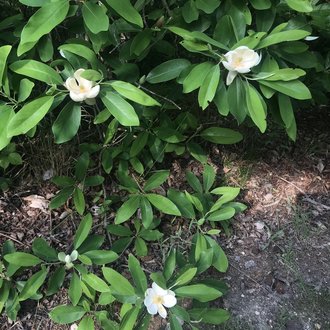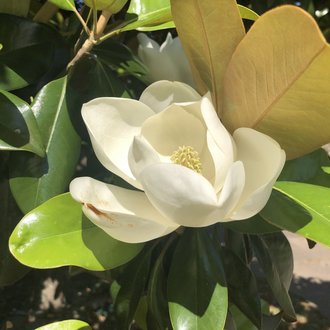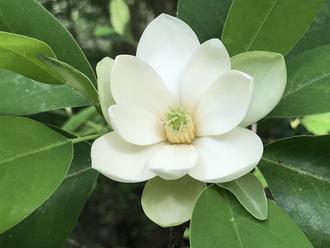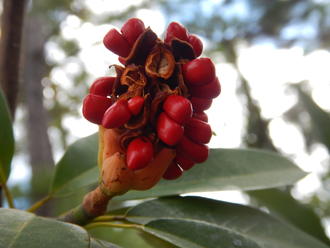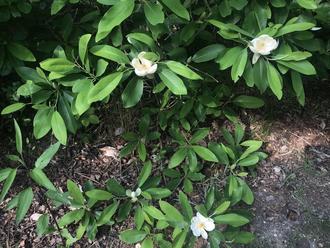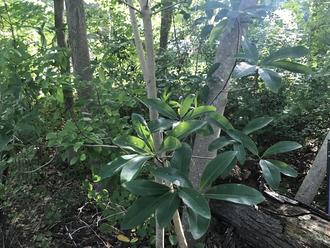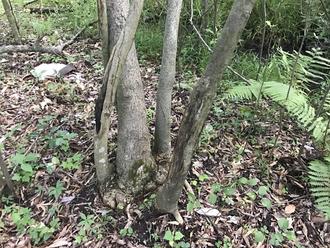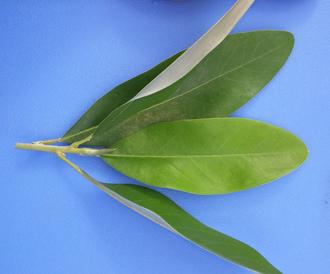Sweetbay Magnolia (Magnolia virginiana L.)
Also known as sweetbay, swamp magnolia, laurel magnolia, swampbay, whitebay, beaver tree.
↑Summary
A small evergreen to deciduous tree of the southeastern coastal plain, preferring wet, acidic, organic soils.
↑Description & Identification
This small tree is evergreen in the south, but semievergreen to tardily deciduous in the north. Northern populations are more likely to grow with multiple trunks, whereas southern populations are more likely to be single-trunked.
↑Similar Plants
↑Habitat
Found in wet woods, swamps and swamp margins, hardwood hammocks, bogs, and floodplains. Most common and abundant in bay forests or pocosins. Found in low-lying depressions and floodplains where soils are usually moist, often saturated and subjected to temporary flooding. Usually found in acidic soils rich in organic matter but low in mineral nutrients, especially phosphorus, calcium, and magnesium.
Mostly limited to the coastal plain of the southeastern U.S., but a few isolated populations occur farther inland. More common at low elevations but can occur up to 1,800 feet in the southern portion of its range.
Found in both early-successional communities and climax communities; in its preferred habitats, persists in the absence of disturbance, but also quickly recolonizes after disturbance.
Much of the habitat of this species has been threatened or reduced by human land use, including for mining, logging, agriculture, and development.
↑Life Cycle
Seedlings often establish under the canopy of other trees, including both hardwoods and conifers (usually pines). Growth however, is often best in sunny gaps or cleared areas. Young plants tolerate a narrower range of moisture conditions, and can be killed by flooding as well as drought.
On favorable sites, seedlings can grow as much as 1-2 feet in their first year. Shaded trees grow much more slowly, but are still able to survive even in heavy shade, with 6-16% full sunlight.
As trees mature, their tolerance of both flooding and drought increases. Trees growing in optimal conditions may produce seed as early as 6 years of age, but many take 10 years or longer. Seed production is relatively consistent from year to year, and may be highly variable by the quality of the site and size of the tree. Little is known about what factors influence seed production. Some populations, especially in the north, rarely produce fruit or produce only small quantities.
Seeds are dispersed by mammals, birds, and also by water and possibly wind.
It is not known whether or not this species persists in seed banks; some magnolias can persist for multiple years in the seed bank, but studies of this species have not confirmed the presence of viable seed in soils, and it is possible that it does not seed bank.
The germination of seeds varies regionally. In northernmost populations, some seeds germinate immediately, without a period of cold stratification, but exposure to cold tends to increase germination, leading seeds to germinate only in spring. However, even slightly farther south in New Jersey, cold seemed to hinder germination.
Trees are able to resprout vigorously if top-killed, such as by fire or logging. Although above-ground parts of the tree are easily killed by fire, the root system is persistent.
The lifespan of individual trees has been estimated at 130 years.
↑Faunal Associations
Sweetbay is relatively important to various animals. The fruits, like other magnolias, are high in fat, and are eaten by birds, including larger birds, and by squirrels and other small mammals. In winter, deer and cattle browse the leaves, which are more tender than most broadleaf evergreens. The leaves are also used in the nests of several songbird species.
The spring shoots and leaves are important in the diet of the American black bear, and areas with sweetbay are important bear habitat. In the south, the species is also an important food for beavers, which eat the bark but rarely fell or girdle trees.
This plant also supports numerous butterflies and moths in their larval form, and numerous other insects, including many that eat magnolias in general, and related plants such as tulip tree.
↑Uses
Widely planted as a landscaping plant, where it is valued for its attractive flowers and foliage and its tolerance of poorly-drained, waterlogged soils. In landscaping, it can survive on more mineral-rich sites where it would not naturally occur due to competition from other plants, but its use in more northerly, inland, and higher-elevation areas is limited by its poor cold-tolerance. On a suitable site though, it is tolerant of air pollution.
In Florida, sweetbay was used successfully in reclamation of a site used for phosphate mining.
↑Related Plants
There are seven other Magnolia species native to North America, and four introduced species. Of these, southern magnolia (Magnolia grandiflora) overlaps most in range, but there is also significant overlap with umbrella-tree (Magnolia tripetala), pyramid magnolia (Magnolia pyramidata), magnolia macrophylla (Bigleaf Magnolia), and cucumber tree (Magnolia acuminata).
After these, the next closest-related plant found in North America is the native tuliptree (Liriodendron tulipifera).
↑Links & External Resources
• Sweetbay | The Wood Database (About This Site)
• Sweetbay | Fire Effects Information System (FEIS) (About This Site)
• Magnolia virginiana (Sweetbay Magnolia) | USDA PLANTS Database (About This Site)
• Magnolia virginiana | Go Botany (About This Site)
• Magnolia virginiana (Sweet Bay Magnolia) | Missouri Botanical Garden Plant Finder (About This Site)
• Sweetbay Magnolia | Virginia Tech Dendrology Factsheets (About This Site)
• Sweetbay | Silvics of North America (About This Site)
• Magnolia virginiana | Biota of North America Project (BONAP) (About This Site)
• Magnolia virginiana | NatureServe Explorer (About This Site)
• Magnolia virginiana | Flora of North America (About This Site)
• Sweetbay | Maryland Biodiversity Project (About This Site)
• Magnolia virginiana L. (Sweetbay, Sweetbay Magnolia, Swamp Magnolia) | Digital Atlas of the Virginia Flora (About This Site)



